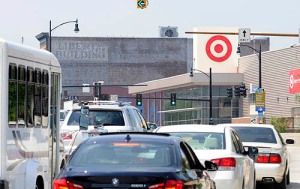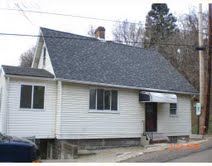<!–
–>The Dark Knight and his entourage touch down in Pittsburgh this week, turning Steel City into Gotham City by coating Downtown streets with snow, rerouting traffic and keeping city officials on hand for pyrotechnics.
Magnus Rex — the working title for “The Dark Knight Rises” — is scheduled to film in Pittsburgh from the end of this week through late August, said Dawn Keezer, director of the Pittsburgh Film Office. And the mayor’s office anticipates the movie’s economic impact will be significant, “in the millions” of dollars.
“This is a tremendous opportunity for Pittsburgh in terms of jobs and exposure,” said Joanna Doven, spokeswoman for Pittsburgh Mayor Luke Ravenstahl.
A July 1 letter from a production company working with Warner Brothers says bus stops will be relocated, about a dozen roads will have sections closed at various times and traffic control will occur when filming takes place Downtown from Aug. 10 to Aug. 20.
Though filming Downtown is scheduled to occur only on Wednesdays through Sundays during the day, the Batman crew could keep hours as late as the Caped Crusader himself with activities occurring as early as 3 a.m. and as late as midnight, according to the Subconscious Productions letter. Also, Carlyle Condominiums residents on Fourth Avenue will be relocated Aug. 17 and 18 during filming, according to the letter.
This movie is the most high-profile film to come to Pittsburgh to date, Keezer said. “The whole difference is people know what this film is because it’s a part of a series,” she said.
The end of filmmaker Christopher Nolan’s Batman trilogy, which is has a scheduled July 20, 2012, release date, will feature Oscar winner Christian Bale as Batman/Bruce Wayne, Anne Hathaway as Selina Kyle (that’s Catwoman for D.C. Comic readers) and Tom Hardy as Bane, the brainy, strong D.C. villain who broke Batman’s back in one comic tale.
Oscar winners Michael Caine and Morgan Freeman will return to the main cast as Alfred and Lucius Fox, respectively.
Bringing in dollars
“The Dark Knight Rises” is shooting in locations worldwide, including sites in India, England and Scotland in addition to the American cities of Pittsburgh, New York and Los Angeles, and filmmakers plan to do more IMAX camera work than was done on “The Dark Knight.”
The BBC reported June 30 that stuntmen dressed in black making parachute jumps at a Scotland Highlands airstrip and a film crew there were working in connection with the film.
For this movie, filmmakers won’t get a break on their budget from Pennsylvania’s Film Tax Credit Incentive because it requires 60 percent of a film’s total production budget to be spent in the Commonwealth to qualify, Keezer said.
Information about the budget for the film is unavailable, but imdb.com estimates that “The Dark Knight” had a budget of $185 million and made more than $1 billion worldwide, according to the Associated Press.
Filmmakers will spend dough on hotels, food and other supplies, and Keezer said all that money will boost the city’s economy. One known expense — Pittsburgh police work — will cost roughly $89,000 for officers to staff barricades and road closures, control traffic and do some escorts, said Christie Gasiorowski, a Pittsburgh police officer in special events.
The Pittsburgh Film Office has helped more than 100 films and TV productions in the Pittsburgh region since 1990 to generate more than $575 million for the area, according to the office’s website.
Connecting with Pittsburgh
The perfect backdrop for Gotham City because of its historic architecture, Pittsburgh could be viewed even more friendly to films if shooting goes well here, said Pittsburgh Downtown Partnership President and CEO Jeremy Waldrup. Recent films such as, “I Am Number Four,” “Unstoppable” “Love and Other Drugs” and others were at least partially filmed in the region.
The inconvenience of having Batman shut parts of Downtown is outweighed by the “wow factor” of having such a major project in the city, blasting special effects and making it snow on Oliver Avenue and Smithfield Street in August, Waldrup said.
“That’s all stuff that you don’t see every day,” he said. “I’m sure folks will try and catch a glimpse.”
But Pittsburghers trying to sneak a peek at Nolan’s latest film project may have to wait for it to hit the silver screen.
“The set is closed,” Keezer said. “It’s not open to the public at all.”
Filmmakers have been working with the Pittsburgh Film Office for the past six months on the movie, preparing for a couple hundred crew members typical of a feature film and more than 10,000 extras to get to work, Keezer said.
More than 8,000 people stood in line at two open casting calls for paid Batman extras Downtown last month, but a Los Angeles casting director said they were looking for only 3,000 extras.
Shooting elsewhere
In addition to all the filming action Downtown, Batman also will be in action at the Steelers’ Heinz Field in early August and at Carnegie Mellon University’s Software Engineering Institute in late July and the university’s Mellon Institute in late July and early August.
Pittsburghers still hoping for an early look at the film can sign up at BeInAMovie.com to be an unpaid extra from 7 a.m. to 7 p.m. on Saturday, Aug. 6, at Heinz Field. Extras ages 14 and up can try their chances at door prizes such as a large flat-screen TV, vintage comics and more while they cheer on the Gotham Rogues in a football game against the Rapid City Monuments. Those under 18 must be accompanied by an adult.
BeInAMovie.com, the film’s publicist, a Steelers spokesman and others did not provide further details about the film.
“I’m afraid that I can’t answer any questions at this time regarding the filming in Pittsburgh,” wrote Claudia Kalindjian, the film’s publicist, in an email. “We are operating a strictly closed set on the film and trying to keep our exposure to a minimum.”
Downtown Pittsburgh street closures
Aug. 9 to Aug. 11:
Oliver Avenue from Wood Street to Grant Street, 8 p.m. Tuesday to 5 a.m. Thursday
Smithfield Street from Fifth Avenue to Sixth Avenue, 8 p.m. Tuesday to 5 a.m. Thursday
Aug. 11 to Aug. 13:
Cherry Way from Third Avenue to Fifth Avenue, 6 p.m. Thursday to 6 a.m. Saturday
Forbes Avenue from Grant Street to Smithfield Street, 6 p.m. Thursday to 6 a.m. Saturday
Fourth Avenue from Grant Street to Smithfield Street, 6 p.m. Thursday to 6 a.m. Saturday
Aug. 12 to Aug. 15:
Smithfield Street from Boulevard of the Allies to Sixth Avenue, 10 p.m. Friday to 6 a.m. Monday
Third Avenue from Wood Street to Cherry Way, 10 p.m. Friday to 6 a.m. Monday
Fourth Avenue from Wood Street to Cherry Way, 10 p.m. Friday to 6 a.m. Monday
Forbes Avenue from Wood Street to Cherry Way, 10 p.m. Friday to 6 a.m. Monday
Fifth Avenue from Wood Street to William Penn Place, 10 p.m. Friday to 6 a.m. Monday
Oliver Avenue from Wood Street to William Penn Place, 10 p.m. Friday to 6 a.m. Monday
Aug. 16 to Aug. 19:
Smithfield Street from Boulevard of the Allies to Forbes Avenue, 10 p.m. Tuesday to 5 a.m. Friday
Third Avenue from Cherry Way to Market Street, 10 p.m. Tuesday to 5 a.m. Friday
Fourth Avenue from Cherry Way to Market Street, 10 p.m. Tuesday to 5 a.m. Friday
Wood Street from Boulevard of the Allies to Forbes Avenue, 10 p.m. Tuesday to 5 a.m. Friday
Aug. 19 to Aug. 21:
Strawberry Way from Coffee Way to Smithfield Street, 7 a.m. Friday to 10 p.m. Sunday
Strawberry Way from Smithfield Street to Grant Street, 11 p.m. Friday to 7 a.m. Sunday
William Penn Place from Sixth Avenue to Liberty Avenue, 11 p.m. Friday to 7 a.m. Sunday
Seventh Avenue from Grant Street to Liberty Avenue, 11 p.m. Friday to 7 a.m. Sunday
Smithfield Street from Sixth Avenue to Liberty Avenue, 11 p.m. Friday to 7 a.m. Sunday
Montour Way from Sixth Avenue to Seventh Avenue, 11 p.m. Friday to 7 a.m. Sunday
Source: Subconscious Productions, Inc.
Street Closings near Carnegie Mellon University
July 25 to Aug. 5:
Dithridge from Fifth Avenue to Winthrop Street, 5 a.m. Monday to 10 p.m. Friday
July 28 to Aug. 5:
Bigelow Boulevard from Fifth Avenue to Forbes Avenue, 8 p.m. Thursday to 10 p.m. Friday
July 29 to July 31:
Utica Way from Henry Street to Winthrop Street, 7 a.m. Friday to 10 p.m. Sunday
July 29 to Aug. 1:
Henry Street from Utica Way to Craig Street, 5 a.m. Friday to 5 a.m. Monday
July 30 to Aug. 1
Fifth Avenue from Bellefield Street to Craig Street, 5 a.m. Saturday to 5 a.m. Monday
July 30 to July 31:
Dithridge Street from Bayard Street to Fifth Avenue (except for local access), 5 a.m. Saturday to 10 p.m. Sunday









 Warner Bros. Pictures
Warner Bros. Pictures






You must be logged in to post a comment.